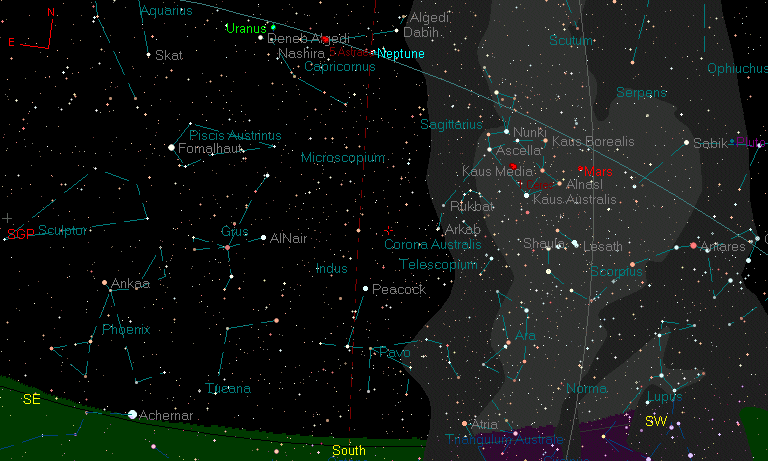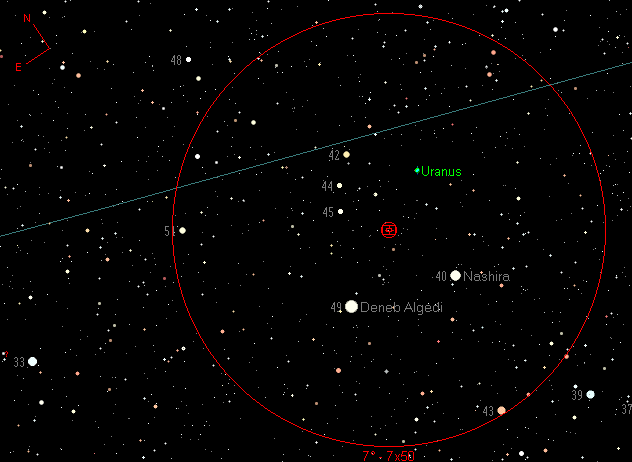

The blue-green line passing near Uranus, Neptune and Mars, is the ecliptic.
The dashed red line is the local meridian.

The typical field of 7x50 binoculars is shown.
And at its center, the telescopic fields used for this observation; ~156X.
These graphics were produced with
TheSky, Software Bisque, version 5.
(SAO 164538 is below and to the left, NE of Uranus, brighter)
Start of the occultation (predicted for Sep. 7, 22:00:00):
From left to right and top to bottom:
The center of frame 29 on 21:58:49.
The center of frame 00 on 21:58:50.
The center of frame 01 on 21:58:50.
The center of frame 02 on 21:58:50.
The center of frame 03 on 21:58:50.
The center of frame 04 on 21:58:50.
The center of frame 05 on 21:58:50.
The center of frame 06 on 21:58:50.
The center of frame 07 on 21:58:50.
The center of frame 08 on 21:58:50.
The center of frame 09 on 21:58:50.
The center of frame 10 on 21:58:50.
![[03-55-29c] pre](03-55-29c.jpg)
![[03-56-00c] pre](03-56-00c.jpg)
![[03-56-01c] pre](03-56-01c.jpg)
![[03-56-02c] occult](03-56-02c.jpg)
![[03-56-03c] occult](03-56-03c.jpg)
![[03-56-04c] occult](03-56-04c.jpg)
![[03-56-05c] occult](03-56-05c.jpg)
![[03-56-06c] occult](03-56-06c.jpg)
![[03-56-07c] occult](03-56-07c.jpg)
![[03-56-08c] occult](03-56-08c.jpg)
![[03-56-09c] occult](03-56-09c.jpg)
![[03-56-10c] occult](03-56-10c.jpg)
(Equal frames during the occultation are omitted)
![[05-10-24c] post](05-10-24c.jpg)
![[05-10-25c] post](05-10-25c.jpg)
![[05-10-26c] post](05-10-26c.jpg)
![[05-10-27c] post](05-10-27c.jpg)
![[05-10-28c] post](05-10-28c.jpg)
![[05-10-29c] post](05-10-29c.jpg)
![[05-11-00c] post](05-11-00c.jpg)
![[05-11-01c] post](05-11-01c.jpg)
![[05-11-02c] post](05-11-02c.jpg)
![[05-11-03c] post](05-11-03c.jpg)
![[05-11-04c] post](05-11-04c.jpg)
![[05-11-05c] post](05-11-05c.jpg)
End of the occultation (predicted for Sep. 7, 22:01:15):
From left to right and top to bottom:
The center of frame 24 on 22:00:04.
The center of frame 25 on 22:00:04.
The center of frame 26 on 22:00:04.
The center of frame 27 on 22:00:04.
The center of frame 28 on 22:00:04.
The center of frame 29 on 22:00:04.
The center of frame 00 on 22:00:05.
The center of frame 01 on 22:00:05.
The center of frame 02 on 22:00:05.
The center of frame 03 on 22:00:05.
The center of frame 04 on 22:00:05.
The center of frame 05 on 22:00:05.
These photograms were made at the primary focus of a Celestron C-5+ SCT, 1,250 mm in focal length, 5" aperture, with a modified (AGC OFF) Supercircuits NTSC TV B/W 1/3" CCD PC23C camera. The original image was recorded in VHS tape, then digitized and transferred to "Mini DV" digital tape, and then captured in .jpg frames for this page.
These frames received the same amount of brightening and contrast enhancement in Paint Shop Pro. North is to the left, East down, in this frames.
The times for the beginning and ending of the occultation (21:58:50 and 22:00:04) are our best estimates, as the times were not recorded on the original VHS tape. But the TV Time Code in the Mini DV tape, superimposed during the digitizing, yields a 74.7 sec. duration in Caracas (N 10° 30.14', W 66° 50.66', Alt. 915 m).
There are 30 frames in each second of digitized NTSC TV image.
The entry into the occultation took some 9 frames; 9 x 1/30 = 0.3 sec.
The exit of the occultation is more difficult to analyze,
as some smog began to cover the sky over Caracas.
But it seems to have taken at least 5 frames; >= 0.17 sec.
Our appreciation, at the time of preliminary data analysis,
was that the brightness of SAO 164538 began to diminish at 21:58:50, frame 02.
And that it was again detectable at 22:00:04, frame 24.
This would be a total duration of 00:01:14, plus 22 frames = 00:01:14.73 = 74.73 sec.
(this could be as short as 74.70 sec. if only 21 frames don't show SAO 164538)
Please note the data has not been calibrated nor reduced, and it should be considered preliminary.
This gradual entry and exit would seem to indicate
the possible presence of an atmosphere in Titania.
But according to David Dunham (IOTA):
"It was probably due to the star's angular diameter, which was expected to take that amount of time [0.26 sec.] (or even a little longer) for the edge of Titania to cover and uncover it."
Thanks to Bruno Sicardi, Paris-Meudon Observatory, and Gontran Eleizalde, Universidad Central de Venezuela.
![]() Occultation of SAO 164538 by Titania:
Occultation of SAO 164538 by Titania:
Titania (mag. 13,9), the biggest satellite of Uranus,
on September 7 '01 near 21:59 (Caracas, 01:59 UTC Sep. 8)
occulted the star SAO 164538 (spectral class K0III, mag. 7,2), in Capricornus.
The event was visible from all of the Windward Islands of the Caribbean, Trinidad,
Venezuela, Colombia and Ecuador (in that order).
On the map of the event, from August 8
(see the page from the
Planetary Occultations Group, Lunar & Planetary Laboratory, University of Arizona, Tucson,
at the bottom of the page),
the central line of the occultation now enters Venezuela from the Gulf of Paria,
and leaves into Colombia by the State of Apure.
The occultation, predicted by Jean Meeus in '99,
and divulged by Claudio Martínez from Argentina,
will be important for determining if Titania has or not an atmosphere.
This will be attempted by the International Occultation Timing Association - European Section,
measuring the slopes of the curve of brightness of SAO 164538 during the beginning
and the end of the event.
It was expected that during the center of the 75 sec. occultation from the central line, the
brightness of SAO 164538 (R.A. 21h 38m 19,6s, Dec. 14° 54' 8,2" S) would be reduced to mag. 13.6.
The occultation lasted for some 74.7 sec., and started 1 minute before the predicted time.
The official announcement by IOTA-ES, is at http://www.iota-es.de/titania1.html.
![]() Uranus (Sep. 7, 22:00);
In the constellation of Capricornus.
Uranus (Sep. 7, 22:00);
In the constellation of Capricornus.
Rose at 17:06, transited at 22:56, set at 04:51,
was located at R.A.: 21h 38m 18,8s, Dec.: 14° 54' 19" S.
Shined with a 5.71 magnitude and its Phase was 99,99%. Had a diameter of some 3.68".
It was possible to observe it after nightfall, in the Eastern sky
(was in Opposition on August 15 '01).
At 22:00 was at an altitude of 61° with an Azimuth of 151° (South by Southeast).
It was some 2° 27' Northwest (300°) of the star Deneb Algiedi
(Delta Capricornii, mag. 2,85),
and some 16" Southwest (224°) of the star SAO 164538, mag. 7,2
(and from Titania, mag. 13,9).
It's disk can be detected, in favorable conditions, with small telescopes.
![]() Times and dates in this page, are local to Venezuela, and calculated for Caracas.
Times and dates in this page, are local to Venezuela, and calculated for Caracas.
Links:
From Titania to large trans-Neptunian objects: ground-based stellar occultations in the quest for the billionth of atmospheric pressure
Thomas Widemann (Observatoire de Paris, LESIA, et Université de Versailles Saint-Quentin)
Titania's radius and an upper limit on its atmosphere from the September 8, 2001 stellar occultation
Icarus vol. 199, 458-476 (2009)
Occultation of star Hipparcos #106829 (SAO 164538) by Titania on September 8, 2001
(Paris-Meudon Observatory)
Mike Kretlow: Occultation of HIP 106829 by Titania
Titania occultation (HIP 106829) (Pedro Ré)
Observing Occultations (Observatorio ARVAL)
![]() This page was updated in: September 12 '01
This page was updated in: September 12 '01
(Calculations revised in January '08, Icarus report published on February '09)
Optimized for MS Internet Explorer
Spanish: Ocultación de SAO 164538 por Titania
Back: Image Gallery
Messages: